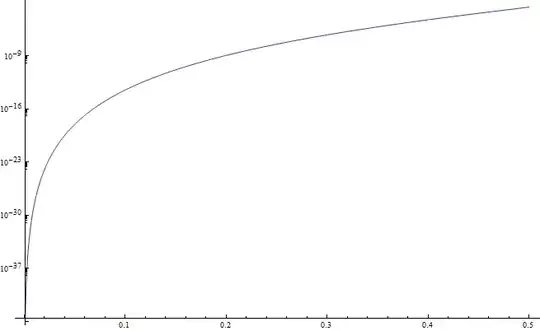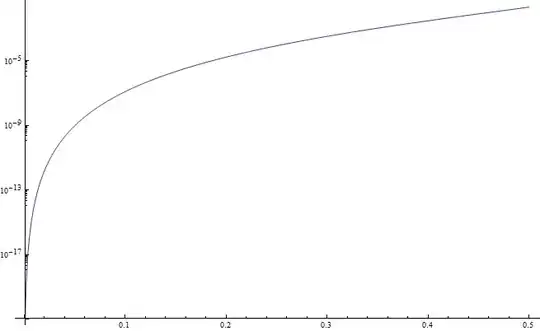Can anyone think of a possible analytical solution of the following equation?
$x\left(1-0.2x^2\right)^{5/2}=constant$
I am not a mathematician, but, it seems to me that only numerical methods can help.
Thanks in advance.
Can anyone think of a possible analytical solution of the following equation?
$x\left(1-0.2x^2\right)^{5/2}=constant$
I am not a mathematician, but, it seems to me that only numerical methods can help.
Thanks in advance.
If you're looking to solve
$$ x\left(1-\tfrac{1}{5} x^2\right)^{5/2} = c $$
when $c$ and $x$ are very small then you can apply the Lagrange inversion formula (see, for example, my answer here) to find $x$ in terms of a power series in $c$. In the formula take
$$f(x) = \left(1-\tfrac{1}{5} x^2\right)^{-5/2}.$$
The first few terms of the series are
$$ x = c+\frac{1}{2}c^3+\frac{27}{40}c^5+\frac{481}{400}c^7+\frac{39151}{16000}c^9+\frac{4308003}{800000}c^{11}+\frac{7987003}{640000}c^{13}+\cdots $$
and truncating the series here gives a good underestimate of the root when $c < 1/2$ which gets better as $c \to 0$.
Here's a plot of the absolute error of this approximation with $c$ on the horizontal axis and a logarithmic scale on the vertical (error) axis.

The approximation is still fairly good if we only use the first three terms of the series. Here's the error in that case:

I'll comment a little bit more here about the (two) positive roots, both when $c \gtrapprox 0$ and when $c \lessapprox 125/216$.
The quantity $x\left(1-\tfrac{1}{5}x^2\right)^{5/2}$ is $0$ when $x=0$, increases to a max of $125/216$ when $x=\sqrt{5/6}$, then decreases to $0$ when $x=\sqrt{5}$. Due to the $5/2$ exponent this quantity is not real for $x>\sqrt{5}$. So (a) when $0<c<125/216$ the equation $x\left(1-\tfrac{1}{5}x^2\right)^{5/2}=c$ has exactly two real solutions, one $<\sqrt{5/6}$ and one $>\sqrt{5/6}$, (b) when $c=125/216$ there is exactly one real solution, namely $x=\sqrt{5/6}$, and (c) when $c>125/216$ there are no real solutions. See this plot:

We gave a series for the solution $< \sqrt{5/6}$ above. The solution $>\sqrt{5/6}$ can be approximated in a slightly different way when $c > 0$ is very small (and hence $x$ is very close to $\sqrt{5}$). We first note that $x\left(1-\tfrac{1}{5}x^2\right)^{5/2}$ is on the order of $(\sqrt{5}-x)^{5/2}$ when $x \approx \sqrt{5}$. If we then substitute $x = \sqrt{5}-y$ and assume a series solution of the form
$$ y = \sum_{k=1}^\infty a_k c^{\tfrac{2k}{5}}, $$
we can expand everything as a series and solve for the coefficients $a_k$ recursively to find that
$$ \begin{align} y&=\frac{5^{3/10}}{2}c^{2/5}+\frac{9}{8\cdot5^{9/10}}c^{4/5}+\frac{77}{400\cdot5^{1/10}}c^{6/5} \\ &\qquad +\frac{3289}{16000\cdot5^{3/10}}c^{8/5}+\frac{63}{256\sqrt{5}}c^2+\cdots \end{align} $$
and hence that the solution in question is approximately
$$ \begin{align} x&=\sqrt{5}-\frac{5^{3/10}}{2}c^{2/5}-\frac{9}{8\cdot5^{9/10}}c^{4/5}-\frac{77}{400\cdot5^{1/10}}c^{6/5} \\ &\qquad -\frac{3289}{16000\cdot5^{3/10}}c^{8/5}-\frac{63}{256\sqrt{5}}c^2+\cdots \end{align} $$
when $c \gtrapprox 0$. We can also perform a similar analysis in the regime where $c \lessapprox 125/216$ to find that our two real solutions are approximately
$$ \begin{align} x^{\pm} &= \sqrt{\frac{5}{6}} \pm \sqrt{\frac{6}{5}} \left(\frac{125}{216}-c\right)^{1/2}+\frac{1}{25} \sqrt{\frac{6}{5}} \left(\frac{125}{216}-c\right) \\ &\qquad \pm \frac{124}{625} \sqrt{\frac{6}{5}} \left(\frac{125}{216}-c\right)^{3/2}+\frac{5197}{78125}\sqrt{\frac{6}{5}}\left(\frac{125}{216}-c\right)^2 + \cdots. \end{align} $$
$x\left(1 - 0.2x^{2}\right)^{5/2} = c\,\sqrt{5\,} = \mbox{constant}$. I ${\bf guess}$ $\left(1 - 0.2x^{2}\right) \geq 0$. Then, $\left\vert x\right\vert \leq \sqrt{5\,}\,$ and ${\rm sgn}\left(x\right) = {\rm sgn}\left(c\right)$. Define $\xi\ \ni\ 0 \leq \xi \leq 1$ and $x \equiv {\rm sgn}\left(c\right)\,\sqrt{5\xi\,}\,$:
$$ \sqrt{\xi\,}\,\left(1 - \xi\right)^{5/2} = \left\vert c\right\vert\,, \qquad \xi\left(1 - \xi\right)^{5} = c^{2} $$
The function ${\rm f}\left(\xi\right) \equiv \xi\left(1 - \xi\right)^{5}$ has its maximum value at $\xi_{M} = 1/6$. ${\rm f}\left(\xi_{M}\right) = 5^{5}/6^{6} \approx 0.0670$. When $\left\vert c\right\vert > 5^{5/2}/6^{3} \approx 0.2588$, there isn't any real solution for $\xi$. When $\left\vert c\right\vert < 5^{5/2}/6^{3} \approx 0.2588$ there are two solutions for $\xi$: 1) $< 1/6$ and 2) $> 1/6$. There are four solutions which can be found approximately:
$$ \begin{array}{ll} \left\vert c\right\vert \gtrsim 0\,, & \qquad & \xi \approx c^{2}\quad\mbox{and}\quad \xi \approx 1 - \left\vert c\right\vert^{2/5} \\[3mm] \left\vert c\right\vert \lesssim{5^{5/2} \over 6^{3}}\,, & \qquad & \xi \approx \xi_{M}\,\,\, \mp\,\,\, \sqrt{2\left[{\rm f}\left(\xi_{M}\right) - c^{2}\right] \over -{\rm f}''\left(\xi_{M}\right)} \end{array} $$ With this information, the numerical approach should be the $Bisection\ Method$.